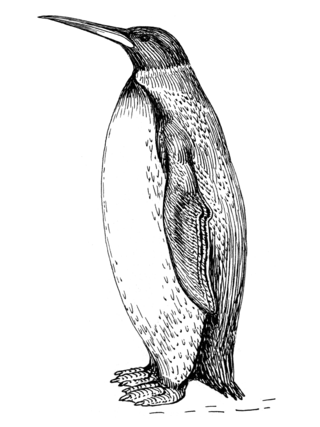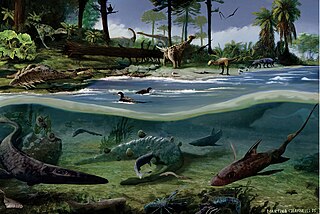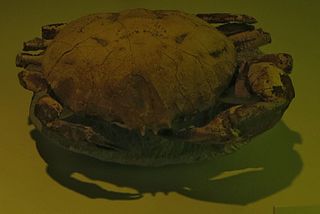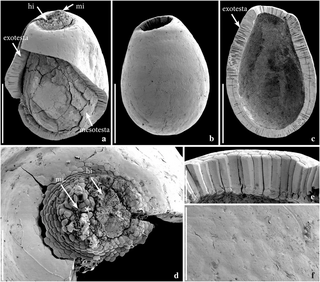
Microbiotheria is an australidelphian marsupial order that encompasses two families, Microbiotheriidae and Woodburnodontidae, and is represented by only one extant species, the monito del monte, and a number of extinct species known from fossils in South America, Western Antarctica, and northeastern Australia.

The South Polar region of the Cretaceous comprised the continent of East Gondwana–modern day Australia, Zealandia, and Antarctica–a product of the break-up of Gondwana in the Cretaceous Period. The southern region, during this time, was much warmer than it is today, ranging from perhaps 4–8 °C (39–46 °F) in the latest Cretaceous Maastrichtian in what is now southeastern Australia. This prevented permanent ice sheets from developing and fostered polar forests, which were largely dominated by conifers, cycads, and ferns, and relied on a temperate climate and heavy rainfall. Major fossil-bearing geological formations that record this area are: the Santa Marta and Sobral Formations of Seymour Island off the Antarctic Peninsula; the Snow Hill Island, Lopez de Bertodano, and the Hidden Lake Formations on James Ross Island also off the Antarctic Peninsula; and the Eumeralla and Wonthaggi Formations in Australia.

Antarctopelta is a genus of ankylosaurian dinosaur, a group of large, quadrupedal herbivores, that lived during the Campanian stage of the Late Cretaceous period on what is now James Ross Island, Antarctica. Antarctopelta is the only known ankylosaur from Antarctica and a member of Parankylosauria. The only described specimen was found in 1986, the first dinosaur to be found on the continent, by Argentine geologists Eduardo Olivero and Robert Scasso. The fossils were later described in 2006 by paleontologists Leonardo Salgado and Zulma Gasparini, who named the type species A. oliveroi after Olivero.

Palaeeudyptes klekowskii, is an extinct species of the penguin genus Palaeeudyptes. It was until recently thought to have been approximately the size of its congener Palaeeudyptes antarcticus, which would mean it was somewhat larger than the modern emperor penguin, but a new study shows it was in fact almost twice as tall, earning it the nickname “Mega Penguin”. Its maximum height is estimated to be up to 2 meters (6.6 ft) and maximum body mass up to 116 kg (256 lb). Knowledge of it comes from an extensive collection of fossil bones from the Late Eocene of the La Meseta Formation on Seymour Island, Antarctica. P. klekowskii was at first not recognized as a distinct species, and despite the coexistence of two so closely related species of similar size as Palaeeudyptes gunnari and P. klekowskii seeming somewhat improbable, the amount of fossil material suggests that the two species are indeed diagnosably different.
Victorlemoinea is an extinct litoptern genus of the family Sparnotheriodontidae, that lived from the Early to Middle Eocene. Fossils of Victorlemoinea have been found in the Las Flores, Sarmiento and Koluel Kaike Formations of Argentina, the Itaboraí Formation of Brazil and La Meseta Formation, Antarctica.

Seymour Island or Marambio Island, is an island in the chain of 16 major islands around the tip of the Graham Land on the Antarctic Peninsula. Graham Land is the closest part of Antarctica to South America. It lies within the section of the island chain that resides off the west side of the peninsula's northernmost tip. Within that section, it is separated from Snow Hill Island by Picnic Passage, and sits just east of the larger key, James Ross Island, and its smaller, neighboring island, Vega Island.
The Lopez de Bertodano Formation is a geological formation in the James Ross archipelago of the Antarctic Peninsula. The strata date from the end of the Late Cretaceous to the Danian stage of the lower Paleocene, from about 70 to 65.5 million years ago, straddling the Cretaceous-Paleogene boundary.

The Snow Hill Island Formation is an Early Maastrichtian geologic formation found on James Ross Island, James Ross Island group, Antarctica. Remains of a paravian theropod Imperobator antarcticus have been recovered from it, as well as the elasmarian ornithopods Trinisaura santamartaensis, Biscoveosaurus and Morrosaurus antarcticus, the ankylosaurian Antarctopelta oliveroi, and the shark Notidanodon sp. Alongside these described genera are also the remains of indeterminate elasmosaurids, lithostrotian titanosaurs and an indeterminate pterosaur.
Antarctodon is an extinct genus of mammals from the Early Eocene. It is a basal astrapotherian which lived in what is now Seymour Island, Antarctic Peninsula, at that moment still connected to South America where most of the astrapotherians were found. The holotype and only specimen MLP 08-XI-30-1, an isolated right p4 or m1, was found in the Telm 5 Member of the La Meseta Formation in West Antarctica. It was first named by Mariano Bond, Alejandro Kramarz, Ross D. E. MacPhee and Marcelo Reguero in 2011 and the type species is Antarctodon sobrali.

Trinisaura is a genus of ornithopod dinosaur that lived during the late Campanian stage of the Upper Cretaceous, around 73 to 72 million years ago in what is now James Ross Island off the coast of northern Antarctica near Patagonia. It is known from a single, incomplete postcranial skeleton that includes several vertebrae, a partial pelvis, and nearly complete right hindlimb. The fossils were collected in 2008 by paleontologists Juan Moly and Rodolfo Coria from the sandstone of the Snow Hill Island Formation. It remained undescribed in the collections of the Museo de La Plata until its description by Coria and colleagues in 2013, being the basis of the novel genus and species Trinisaura santamartaensis. The genus name is to commemorate the efforts of Argentine geologist Trinidad "Trini" Diaz and the Latin root -sauros, meaning "lizard". The species name is after Santa Marta Cove, where the fossils were collected.

Llanocetus is a genus of extinct toothed baleen whales from the Late Eocene of Antarctica. The type species, Llanocetus denticrenatus, reached gigantic proportions, with the juvenile specimen reaching an estimated 8 m (26 ft) in length; a second, unnamed species, known only from three isolated premolar teeth, reached an estimated total body length of up to 12 m (39 ft). Like other contemporary baleen whales of the Eocene, Llanocetus completely lacked baleen in its jaws. It was probably a suction feeder like the modern beaked and pygmy right whales.

Kaikaifilu is an extinct genus of large mosasaurs that lived during the Late Cretaceous (Maastrichtian) in what is now northern Antarctica. The only species known, K. hervei, was described in 2017 from an incomplete specimen discovered in the López de Bertodano Formation, in Seymour Island, Antarctic Peninsula. The taxon is named in reference to Coi Coi-Vilu, a reptilian ocean deity of the Mapuche cosmology. Early observations of the holotype classify it as a member of the subfamily Tylosaurinae. However, later observations note that several characteristics show that this attribution is problematic.

Crossvallia is an extinct genus of penguins. It includes two species, C. unienwillia and ?C. waiparensis. Their anatomy suggests that the genus is closely related to the Anthropornithinae.

Imperobator is a genus of paravian theropod, a group of large, three-toed carnivorous dinosaurs, that lived during the Maastrichtian age of the Late Cretaceous period in what is now James Ross Island in Antarctica. Imperobator is one of only two non-avian theropods known from Antarctica, crossing over to the landmass when it was part of Gondwana. The only described specimen was found in 2003 by an expedition launched by the University of California Museum of Paleontology and initially described as a dromaeosaur in 2007. However, later searches reported more fossils from the site including teeth and skull bones. The fossils were formally described as a new genus of giant paravian in 2019.
Woodburnodon is an extinct genus of microbiotherian marsupial whose fossils have been found on Seymour Island, Antarctica. It lived during the Eocene epoch.

Tumidocarcinus is an extinct genus of crabs in the family Tumidocarcinidae, containing the following species:
Notiolofos is an extinct genus of sparnotheriodontid ungulate from the order Litopterna. The animal lived during the Eocene, in modern-day Antarctica. The genus contains two species, N. arquinotiensis, the type species, and N. regueroi.
Sparnotheriodontidae is an enigmatic extinct family of litopterns known primarily from teeth. Sparnotheriodontids are one of two South American native ungulate clades known to have reached Antarctica, the other being astrapotheres.

Notonuphar is an extinct genus of water lily in the family Nymphaeaceae. It contains a single species, Notonuphar antarctica. It is only known only from the Eocene-aged La Meseta Formation of Seymour Island, Antarctica.



















